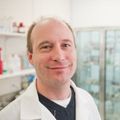EVENT DETAILS:
DATE: May 16, 2017
TIME: 9:00am PT, Noon ET
Thermo Fisher Scientific is proud to present the SyncD3 webinar series. As a thought-leader in science our first commitment is to you the scientist and partnering to drive the conversation on current practices, standards and the development of innovation.
Join us for our continuation of the SyncD3 webinar series and virtual event, where we will discuss cutting-edge tools and topics in the field(s) of Drug Discovery & Development such as:
- HCS/Phenotypic Assays
- Functional Genomics & Drug Metabolism
- 3D models/Organoids
- Diseased models
- CRISPR
- Stem Cells
We will discuss where these areas intersect and impact drug discovery and development and the future of the industry during a live panel discussion with our presenters and you the audience. Learn from real field scientists and researchers who are working in the ADME/Tox and Drug Discovery fields and bring your questions for the open forum Q&A session after our presentations.
If you cannot make the live presentation you are always capable of accessing the recorded information, presentations and Q&A any time after the event by registering here.
ADME/Tox Presentation: 3D Cell Culture: Developing Better In Vitro Cell Models For Drug Discovery
Organoids are emerging as advanced 3D cell models that have the potential to revolutionize our understanding of human development and disease. This technology can be utilized to generate ‘micro-tissues’ from human embryonic or adult stem cells and iPSCs, that histologically resemble normal tissues and recapitulate some of the functional capabilities of their in vivo counterparts. These features suggest organoids may also have unique advantages for drug discovery and the potential for personalized toxicology. This talk will give a general overview of organoid technology and other 3D cell models highlighting ongoing R&D activities at Thermo Fisher Scientific.
Drug Discovery Presentation: Using iPSCs and Genome Engineering to Build Disease Models
Developing therapies for human diseases continues to face obstacles, particularly in translating targets or compounds identified by in vitro screening campaigns to valid targets or efficacious and safe compounds once tested in humans. Here we discuss strategies that leverage induced pluripotent stem cells (iPSCs) to increase the relevance of cell models for these in vitro approaches. We review current advances in genome engineering and how to leverage a portfolio of these tools to generate knock-out and knock-in models for use in target or compound identification. Specifically, we demonstrate this approach with induced pluripotent stem cells (iPSCs) to build isogenic disease models, which can be further differentiated to various cell types of interest that are more directly related to a disease area than commonly used immortalized cell lines. We expect strategies combining genome engineering and stem cells to provide platforms for more robust disease models that will provide more predictable translation of in vitro to in vivo results.






